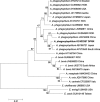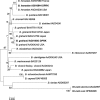Prevalence of Anaplasma, Bartonella and Borrelia Species in Haemaphysalis longicornis collected from goats in North Korea
- PMID: 26645342
- PMCID: PMC4921669
- DOI: 10.4142/jvs.2016.17.2.207
Prevalence of Anaplasma, Bartonella and Borrelia Species in Haemaphysalis longicornis collected from goats in North Korea
Abstract
North Korea is located on the northern part of the Korean Peninsula in East Asia. While tick-borne pathogens of medical and veterinary importance have been reported from China and South Korea, they have not been reported from North Korea. To screen for zoonotic tick-borne pathogens in North Korea, ticks were collected from domestic goats. A total of 292 (27 nymph, 26 male, 239 female) Haemaphysalis (H.) longicornis were collected and assayed individually for selected tick-borne pathogens. A total of 77 (26.4%) were positive for Anaplasma bovis, followed by Bartonella (B.) grahamii (15, 5.1%), Anaplasma phagocytophilum (12, 4.1%), Bartonella henselae (10, 3.4%), and Borrelia spp. (3, 1.0%) based on 16S ribosomal RNA and ITS species-specific nested polymerase chain reaction. Using the groEL-based nested PCR, a total of 6 and 1 H. longicornis were positive for B. grahamii and B. henselae, respectively. All products were sequenced and demonstrated 100% identity and homology with previously reported sequences from other countries in GenBank. This is the first report of the detection of tick-borne pathogens in the North Korea and suggests that farm animals may act as reservoirs for zoonotic tick-borne pathogens.
Keywords: Anaplasma; Bartonella; Borrelia; Haemaphysalis longicornis; North Korea.
Conflict of interest statement
Figures






References
-
- Barlough JE, Madigan JE, Derock E, Bigornia L. Nested polymerase chain reaction for detection of Ehrlichia equi genomic DNA in horses and ticks (Ixodes pacificus) Vet Parasitol. 1996;63:319–329. - PubMed
-
- Billeter SA, Levy MG, Chomel BB, Breitschwerdt EB. Vector transmission of Bartonella species with emphasis on the potential for tick transmission. Med Vet Entomol. 2008;22:1–15. - PubMed
MeSH terms
LinkOut - more resources
Full Text Sources
Other Literature Sources
Molecular Biology Databases
Research Materials
Miscellaneous

